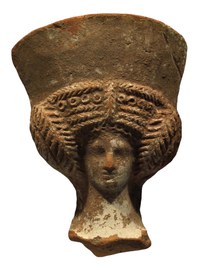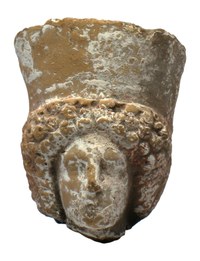Great festive hairstyles
Between 425 and 375 BC, terracotta statuettes with particularly voluminous, complicated hairstyles were created in Boeotia, and only there[1]. Some of these 'superstructures' are inconceivable without the use of hairpieces and wigs. The question of which persons were depicted with such elaborate headdresses, and for which occasions, is always a cause for discussion. Female figures predominate, but one type of youthful figure is also characterised by sweeping hairstyles adorned with bead bandages. The statuettes come from shrines and tombs. While the attributes of the women, bandages and boxes, bowls and jugs, point to a cultic connection, this connection seems less certain for the elaborate hairstyles. Holzhausen, for example, considered it possible[2] that the coroplasts, starting from Boeotian everyday hairstyles, would have arranged and decorated them in a particularly elaborate way to increase the pretension and attractiveness of their terracotta figures.
In contrast to the festively dressed women, the young men are naked except for a long back coat. They usually hold a cock in their arms[3], the popular gift of Erasthes to Eromenos, but also a welcome sacrifice to gods such as Dionysus or Asclepius[4].
|
Inv. T I-34. Front side from the mould. Back not finished, smoothed, concave at the polos, rounded at the head and neck. Traces of sintering. Provenance: Acquired by Bruno Sauer in 1907. State of preservation: Head with neck and polos. Crack and bump on the upper left edge of the polos. Brown clay (7.5YR 6/5) with inclusions. Abundant white engobe, especially on the neck. Traces of red paint in the hair, especially on the right side. Dimensions: H: 10,7 cm; W: 7,5 cm; D: 3,5 cm References: Not published. |
|
Description: Dainty head with sweeping coiffure and broad polos. A small crown braid leads vertically upwards over the middle of the forehead. From there, flatly curved, densely layered herringbone-like stylised strands emanate; a band of small curling rings is interposed in between. At the sides, voluminous pieces of hair, also composed of herringbone motifs, slant upwards. Small forelocks emerge from under this 'build-up'. |
Commentary: The fine forelocks are obviously her own hair[5]. Together with the wide polos, the weight of the elaborately coiffed wig seems almost too heavy for the petite head and long neck. The female figures with this distinctive headdress are usually dressed in a belted peplos and hold attributes used in the cult in their hands[6].
The head casting T I-34 is indicated frontally, looking forward. Parallels from the excavation at Halae were made between 420 and 390 BC according to the find context[7]. A female figure with a comparable head type follows here; she carries a swan on her left arm, places her left foot on a column capital and grasps her cloak with her right arm reaching far out[8]. Her head is turned slightly to the left. In comparison with this moving figure, which is dated to the beginning of the 4th century BC, the Giessen head could have been created about a generation earlier, in the last quarter of the 5th century BC.
Determination: 420/410 BC, Boeotia.
----------------------------------------
Description: The comparatively high polos becomes slightly wider towards the top. It crowns a bouffant coiffure parted above the forehead, consisting essentially of three registers of thick curls. At the sides, below a slight retraction at the level of the ears, the strands are stylised in the manner of corkscrew curls[9]. The face is oval, with smooth cheeks and accentuated chin. Full, curved lips form the small mouth. The eyes, framed by fine lids, are close together.
Description: The female half-figure, rendered as a thin-walled relief, wears a peplos with a short overlay. A cloak drawn over the back of the head falls in plastically curved folds on both sides of the neck onto the shoulders. Above it, a thin veil, also ending at the shoulders, spreads around the head like a foil.
The neck tapers conically; at the bottom it takes up the whole width of the robe neckline. On the left side, above the plastically indicated edge of the peplos, a part of the painted chain is indicated. The arms are bent in front of the chest. In her upward pointing fingers the woman probably held blossoms or small fruits[14].
The face is framed by a voluminous hairstyle. From the centre parting, strands laid in uniform short waves go to either side, where they are intersected by long strands gathered into a mop of hair at the top of the head. Between the sections of the hairstyle lies a delicate crescent-shaped tiara. The ears are adorned with drop-shaped pendants.
The elongated oval face is dominated by the large nose. The smooth cheeks narrow rapidly and merge into a prominent chin. Narrow lids, the lower of which is almost horizontal, the upper arched, frame the eyes. Above the lower orbits the brows stand out vividly. Full curved lips form the closed mouth.
| Commentary: Hairpieces were probably used for the elaborate hairstyle. The gestures of the female half-figures[15] are repeated in the widespread male protomes called Dionysus, the majority of which also come from Boeotian workshops[16]. Occasionally, even parts of the female hairstyle have been adopted for the image of the bearded god, with wreath and bandages[17] taking the place of diadem and veil. A close parallel to the Giessen half-figure can be found in the Museum of Thebes[18]. Similar examples with varied hairstyles and changing veil drapery[19] come from the necropolis of Halae[20]. Stylistically, T I-38 is reminiscent of features of the Severe Style; the dominance of the lower face and the long smooth cheeks speak for this. The parallels from Halae are dated to the 2nd half of the 5th century BC by ceramic finds[21]. |
The face is oval, with a pointed chin, smooth large-set cheeks, strong nose and deep-set eyes. Full lips form the small mouth.
| Commentary: In the lateral and semi-oblique shots, one can see a suggestion of further loops descending from the bead crest to cheek level on each side[23]. The skin appears white, but a comparable head from the Loeb Collection in Munich shows a reddish-brown painting on white engobe[24]. Thus, it is possible that the uncovered parts of the skin on the Giessen head were originally painted dark in the manner typical of male figures. The specimen T II-6 belongs to the group of 'standing youths in a back coat with a cock', whose find sites are concentrated on Boeotian sanctuaries and necropolises[25]. Stylistically, it follows parallels from the context of Halae (group F, 390-350 BC)[26]. From the side view, the round sculpture of the head is evident. This is matched by the gradual transition of the cheeks into the depths. At the sides, however, the view is limited by the sweeping hairstyle. |
[1] U. Liepmann, Griechische Terrakotten-Bronzen-Skulpturen, Kästner-Museum (Hannover 1975) 20; „in … einer für den böotischen Provinzialismus bezeichnenden Übertreibung“, E. Paul, Antike Welt in Ton (Leipzig 1959) 27.
[2] H.-J. Holzhausen, Böotische Terrakottatypen des 5. und 4. Jahrhunderts vor Christus, Diss. Dresden (Bonn 1972) 82 f.
[3] R. A. Higgins, Cat. of the Terracottas in the Department of Greek and Roman Antiquities British Museum (London 1954) 232 no. 871 pl. 124.
[4] L. Frey-Asche, Tonfiguren aus dem Altertum (Hamburg 1997) 50-52 fig. 30.
[5] F. W. Hamdorf, Die figürlichen Terrakotten der Staatlichen Antikensammlungen München (Lindenberg 2014) 191 fig. D 114; N. Breitenstein, Cat. of Terracottas. Danish National Museum (Copenhagen 1941) 31 no. 285 fig. 32; R. Wünsche – M. Steinhart (Hrsg.), Sammlung James Loeb (Lindenberg im Allgäu 2009), 116 f. fig. 52; K. Demakopoulou – D. Konsola, Archäologisches Museum Theben (Athen 1981) 65 pl. 35 a; E. Paul, 50 Meisterwerke. Antikenmuseum Leipzig, 23 fig. 46; R. Higgins, Tanagra and the Figurines (London 1986) 103 fig. 119.
[6] Paul ibid. 23 fig. 46; R. Higgins ibid. 102 f. fig. 119; Breitenstein ibid. 31 no. 286 pl. 32. E. Schmidt, Katalog der antiken Terrakotten Martin-von-Wagner-Museum der Universität Würzburg (Mainz 1994) 52 f. no. 53 pl. 13 b. R. A. Higgins ibid. 225 no. 846 pl. 117; Hamdorf ibid. 2014, 191 fig. D 112. Wünsche – Steinhart ibid. 116 f. fig. 52; Breitenstein ibid. 31 no. 287 pl. 32. A. Köster, Die griechischen Terrakotten (Berlin 1926) 95 pl. 19; Winter 1, 1903, 67, 1. 2. Hamdorf ibid., 2014, 192 fig. D 116; S. Mollard-Besques, Cat. Figurines I (Paris 1954) 86 C 23 pl. 60: Hamdorf ibid. 2014, 192 f. D 116-120; H. Goldman – F. Jones, Terracottas from the Necropolis of Halae, Hesperia 11, 1942, 395 no. 16 pl. 9 b. Winter 1, 1903, 66, 8.
[7] Goldman – Jones ibid. 391.
[8] Berlin, P. Jacobsthal, AM 57, 1932, 72 fig. 4.
[9] Liepmann ibid. 65 no. T 50.
[10] "Saugnapflocken", Liepmann ibid.
[11] Goldman – Jones ibid. 395. 401 no. 15 and 18 pl. 9; R. A. Higgins ibid. 226 fig. 850 pl. 118; V. Vassilopoulou – N. Skoumi – E. Nassioti, Aphrodite Figurines from the sanctuary of "Nymph Koronia" at Mount Helicon, in: A. Muller – E. Laflι (eds.), Figurines de terre cuite en Méditerranée grecque et romaine 2 (Villeneuve d'Ascq 2015) 475 f. fig. 2 b.
[12] Goldman – Jones ibid. 395. 401 no. 15. 18 pls. 9 a and c.
[13] A. Schwarzmaier, "Ich werde immer Kore heissen" - Zur Grabstele der Polyxena in der Berliner Antikensammlung, JdI 121, 2006, 175-179 figs. 1-3: ibid. 205 f. figs. 27 and pl. 1; Goldman – Jones ibid. 395 nos. 13. 14 pl. 8.
[14] Demakopoulou – Konsola ibid. 65 pl. 36.
[15] R. A. Lunsingh Scheurleer, Grieken in het klein (Amsterdam 1986) 42 fig. 26; Winter 1, 1903, 249, 1-5. 251, 1. 2. 4.
[16] R. A. Higgins ibid. 233 no. 874 pl. 126; Lunsingh Scheurleer ibid. 42 f. fig. 27; Higgins ibid. 233 no. 873 pl. 125; S. Besques, Figurines et reliefs grecs en terre cuite (Paris 1994) 56 fig. 28; K. Gschwantler – W. Oberleitner, Götter Heroen Menschen (Wien 1974) 29 no. 70 pl. 15
[17] A. Furtwängler, AA 1888, 253 no. 4; Winter ibid. 248, 5.
[18] Demakopoulou – Konsola ibid. 65 pl. 36; Breitenstein ibid. 31 no. 283 pl. 32.
[19] Hamdorf 2014 A: o: 227 f. D 217 S. Pfisterer-Haas, Antike Terrakotten (Leipzig 1996) 16 f. no. 12; Winter 1, 1903, 247, 2.
[20] "Masks", Goldman – Jones A: o: 390. 397 no. 16 and 17 pl. 17 f.; A. Laumonier, Cat. de Terres cuites du Musée archéologique de Madrid (Paris 1921) 20 f. no. 51 pls. 19, 21. Paul 1994 ibid. 25 fig. 50.
[21] Goldman – Jones 1942, 385-397 pls. 4. 5. 17. 18.
[22] Cf. Th. Stephanidou-Tiveriou, Pilina Eidolia (Thessaloniki 1982) 39 f. no. 33 figs. 40. 42; H. Froning, Monumentale Statuette eines stehenden jungen Mannes mit Hahn, in: E. Simon (ed.), Die Sammlung Kiseleff 2 (Mainz 1989) 173 no. 278 pl. 107; B. Schmalz, Terrakotten aus dem Kabirenheiligtum bei Theben (Berlin 1974) 161 figs. 150-152 pl. 11.
[23] Cf. M. Szabó, Contribution a la question des ateliers de terre cuite beotiens de l'epoque classique tardive, BMusHong 37, 1971, 11 fig. 4. 5; for the development of the hairstyle and the varied headdress above all: B. Schmaltz, Jünglinge mit Hahn, in: id. ibid. 45-71 figs. 143-159 pls. 10-12; F. W. Hamdorf, Die figürlichen Terrakotten der staatlichen Antikensammlungen München I (Lindenberg im Allgäu 2014) 211 f. D 174-178..
[24] F. W. Hamdorf, Hauch des Prometheus (München 1996) 96 f. fig. 120.
[25] L. Frey-Asche, Tonfiguren aus dem Altertum (Hamburg 1997) 51 f.; Schmaltz ibid. 76; Goldman – Jones ibid. 1942, 403 no.




